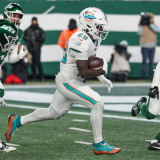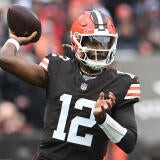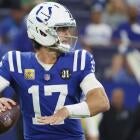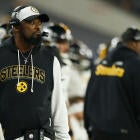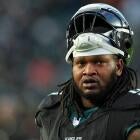Sapp, among most dominant DTs ever, no surprise for Hall of Fame
Warren Sapp made it to Canton on his first try -- as a defensive tackle -- and former Ravens tackle Jonathan Ogden knows why.

CANTON, Ohio -- Warren Sapp is an anomaly, and I'm not talking about what he says or does on TV or social media. I'm talking about his induction to the Pro Football Hall of Fame.
He's a first-ballot choice ... as a defensive tackle.
Usually, there's a queue at the position, with recent inductees like John Randle and Cortez Kennedy put on call waiting. Randle broke through on his second try as a finalist; Kennedy didn't get to Canton until his fourth, and that's more the rule than the exception. Prior to Sapp, for instance, only four defensive tackles -- Bob Lilly, Randy White, Merlin Olsen and Joe Greene -- were inducted to the Hall in their first years of eligibility ... but none after 1994.
That's why Sapp's election is noteworthy. When he was up for election in February, the choice figured to come down to him or Michael Strahan -- with the smart money on Strahan. But Sapp pulled the upset, and there's a reason: The guy was damned good at what he did, which was dominate the line of scrimmage, and don't take it from me.
Listen to former Baltimore tackle Jonathan Ogden who joins Sapp in this year's class.
"When you lined up against him," he said at Thursday night's reception, "you knew you were playing one of the best to ever play the game."
That right there would qualify Sapp for enshrinement. But so does this: He was the glue to a Tampa Bay defense that not only was one of the game's best at the turn of the new century, but that launched the Bucs to their first Super Bowl victory in franchise history.
People don't remember Brad Johnson, Warrick Dunn, Mike Alstott or Keyshawn Johnson from that team as much as they do the leaders of a defense that smothered opponents, with Sapp at the head of the class.
He could rush the passer. He could control the line. He plugged holes. He engulfed ballcarriers. Basically, he was the key piece to Monte Kiffin's Tampa-2, the guy who made everyone around him -- Simeon Rice, Derrick Brooks, John Lynch, Ronde Barber, everyone -- better.
But he was more than a raging bull so accomplished at what he did that he was named the league's Defensive Player of the Year. He was an oversized personality, too, a big man with plenty to say ... and not all of it good.
"He could talk a good game, that's for sure," said Ogden. "But he actually backed it up on the field. He's one of those guys you had to game-plan for. [In Baltimore], we'd say, 'How do you deal with Number 99?' Whenever you have a defensive player you have to sit in a room for 10 minutes and devise a plan for, that's how you know a guy's a Hall of Famer.
"He could wreak havoc if you let him. We'd have to plan how our guards and tackles would handle him on the field. He was that good. I remember one game we played them, and he's supposed to line up on the guard in a 'three-technique,' right? Well, for some reason, he'd always line up way outside of me ... and Simeon Rice would be even further outside.
"So I said to him, 'What are you doing out here, man?' And he said, 'This is just where I line up.' So he lines up against me, and I poke him right in the ribs, and he kind of has this look on his face like ... huh? (And I was like) 'Oh? Did I just do that?'
"It was funny at the time. I know I did one of those sneaky, lowdown, dirty moves, but I had to end up laughing about it. And he laughed about it, too. He just told me, 'That's a good shot. Let's keep playing.' "
And they did. They played and played and played until they both made it the Hall on their first tries. Larry Allen made it on his first try, too. But it took Bill Parcells four years as a finalist before he cashed in; Cris Carter didn't make it until his sixth year as a finalist. And Dave Robinson and Curley Culp had to wait three to four decades before their names were called.
Most players and coaches go home when they retire. Few go to Canton. Fewer still make it on their first try. Warren Sapp is one of them. Now you know why.

